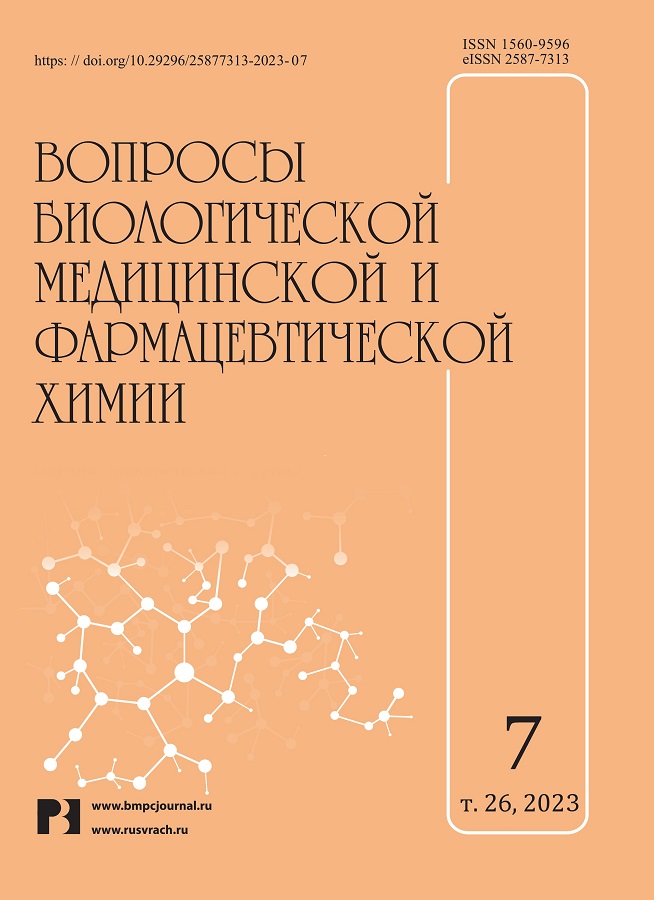Correlation of the component composition of humic acids of peloids with their polymodal action
- Authors: Zhernov Y.V.1, Krivopalova M.A.2, Mizina P.G.3, Avvakumova N.P.2, Zhdanova A.V.2, Sevastyanova A.V.2
-
Affiliations:
- Sechenov First Moscow State Medical University of the Ministry of Health of the Russian Federation (Sechenov University)
- Samara State Medical University of the Ministry of Health of Russia
- All-Russian Scientific Research Institute of Medicinal and Aromatic Plants
- Issue: Vol 26, No 7 (2023)
- Pages: 12-19
- Section: Pharmaceutical chemistry
- URL: https://journals.eco-vector.com/1560-9596/article/view/568654
- DOI: https://doi.org/10.29296/25877313-2023-07-02
- ID: 568654
Cite item
Abstract
Relevance. The source of humic substances and the method of isolation determines their structure, the specificity of binding of individual fragments, the degree of condensation and conjugation, molecular weights and other characteristics. Humic acids of peloids have a high pharmacological activity due to the presence of various functionals in their composition, which, along with a high molecular weight, allows them to be attributed to the group of polyelectrolytes and determines the universality of the effect.
The aim of the work was to identify the components of humic acid hydrolysate of low-mineralized silt sulfide mud to substantiate their polymodal action.
Material and methods. The object of the study was a solution obtained by extraction into hexane, products of acid hydrolysis of humic acids. The obtained samples were studied using the following methods: chromatography-mass spectrometry (GC-MS) on an Agilent 7890 A chromatograph, IR spectroscopy on a Perkin-Elmer System - 2000 spectrophotometer, elemental quantitative analysis on a Vario EL analyzer.
Results. GC-MS analysis of humic acid hydrolysis products showed the presence of acidic components in the sample and includes both low- and high-molecular fatty monobasic and dibasic acids of saturated unsaturated type. The presence of phenolic derivatives of acrylic acid in the composition causes the inhibitory effect of HA on cell proliferation. The neutral fraction is represented by high-molecular alcohols of natural origin.
Conclusion. Thus, the above components of the hydrolysate justify the currently established and potentially possible effects of humic acids of peloids.
Keywords
Full Text
About the authors
Y. V. Zhernov
Sechenov First Moscow State Medical University of the Ministry of Health of the Russian Federation (Sechenov University)
Author for correspondence.
Email: a.v.zhdanova@samsmu.ru
Dr.Sc. (Med.), Associate Professor, Professor of the Department of General Hygiene
Russian Federation, MoscowM. A. Krivopalova
Samara State Medical University of the Ministry of Health of Russia
Email: a.v.zhdanova@samsmu.ru
Ph.D. (Chem.), Associate Professor, Associate Professor of the Department of Medical Chemistry
Russian Federation, SamaraP. G. Mizina
All-Russian Scientific Research Institute of Medicinal and Aromatic Plants
Email: a.v.zhdanova@samsmu.ru
Dr.Sc. (Pharm.), Professor, Advisor
Russian Federation, MoscowN. P. Avvakumova
Samara State Medical University of the Ministry of Health of Russia
Email: a.v.zhdanova@samsmu.ru
Dr.Sc. (Biol.), Professor, Professor of the Department of Medicinal Chemistry
Russian Federation, SamaraA. V. Zhdanova
Samara State Medical University of the Ministry of Health of Russia
Email: a.v.zhdanova@samsmu.ru
Ph.D. (Pharm.), Associate Professor of the Department of Medicinal Chemistry
Russian Federation, SamaraA. V. Sevastyanova
Samara State Medical University of the Ministry of Health of Russia
Email: a.v.zhdanova@samsmu.ru
Post-Graduate Student, the Department of Medical Chemistry
Russian Federation, SamaraReferences
- Buzlama A.V., Chernov Ju.N. Perspektivy ispol'zovanija solej guminovyh kislot dlja razrabotki novyh lekarstvennyh preparatov. V sbornike: Puti i formy sovershenstvovanija farmacevticheskogo obrazovanija. Sozdanie novyh fiziologicheski aktivnyh veshhestv. Materialy 6-j Mezhdunarodnoj nauchno-metodicheskoj konferencii «Farmobrazovanie-2016». FGBOU VO "Voronezhskij gosudarstvennyj universitet". 2016: 196–198.
- Perminova I.V., Hatfield K. Remediation chemistry of humic substances: theory and implications for technology. Use of Humic Substances to Remediate Polluted Environments: From Theory to Practice, NATO Science Series IV: Earth and Environmental Sciences 52, Springer, Dordrecht, The Netherlands. 2005; 1: 3–36.
- Avvakumova N.P., Krivopalova M.A., Glubokova M.N., Katunina E.E., Zhdanova A.V. Poluchenie i svojstva nizkomineralizovannyh ful'vovyh kislot peloidov. Voprosy biologicheskoj, medicinskoj i farmacevticheskoj himii. 2020; 23(5): 3–9.
- Logvinova L.A., Zykova M.V., Krivoshhekov S.V., Drygunova L.A., Perederina I.A., Golubina O.A., Perminova I.V., Konstantinov A.I., Belousov M.V. Sravnitel'noe farmakognosticheskoe issledovanie nizinnyh drevesno-travjanyh vidov torfa razlichnogo proishozhdenija dlja obosnovanija ih ispol'zovanija v kachestve perspektivnyh istochnikov biologicheski aktivnyh guminovyh kislot. Himija rastitel'nogo syr'ja. 2022; 1: 277–288.
- Avvakumova N.P., Mizina P.G., Krivopalova M.A., Zhdanova A.V., Katunina E.E., Glubokova M.N. Protivovospalitel'naja aktivnost' guminovyh kislot peloidov. Voprosy biologicheskoj, medicinskoj i farmacevticheskoj himii. 2018; 21(6): 33–37.
- Buzlama A.V., Starov V.A. Izuchenie pronicaemosti membran jeritrocitov pod vlijaniem sapropelevogo gumata. Zdorov'e i obrazovanie v XXI veke. 2010; 12(4): 441–442.
- Zhernov Ju.V., Haitov M.R. Mikrobicidy dlja topicheskoj immunoprofilaktiki VICh-infekcii. Bjulleten' sibirskoj mediciny. 2019; 18(1): 49–59.
- Zhernov Ju.V., Zhdanova A.V., Avvakumova N.P., Haitov M.R. Immunoantioksidantnaja aktivnost' guminovyh kislot. Rossijskij allergologicheskij zhurnal. 2018; 15(S1-2): 30–31.
- Zhernov Y.V., Konstantinov A.I., Zherebker A., Nikolaev E., Orlov A.A., Savinykh M. I., Kornilaeva G.V., Karamov E.V., Perminova I.V. Antiviral activity of natural humic substances and shilajit materials against HIV-1: relation to structure. Environ. Res. 2020: 110312; https://doi.org/10.1016/j.envres. 2020.110312.
- Joly H.A., Li H., Belzile N. Pyrolysis gas chromatography – mass spectrometry of humic substances extracted from Canadian lake sediments. Canadian Journal of Chemistry. 2000; 78(1): 51–63; https://doi.org/10.1139/v99-228.
- Zykova M.V., Brazovsky K.S., Veretennikova E.E., Danilets M.G., Logvinova L.A., Romanenko S.V., Trofimova E.S., Ligacheva A.A., Bratishko K.A., Yusubov M.S., Lyapkov A.A., Belousov M.V. New artificial network model to estimate biological activity of peat humic acids. Environ. Res. 2020; 191: 109999; https://doi.org/ 10.1016/j.envres.2020.109999.
- Avvakumova N.P., Stepanov G.V., Krivopalova M.A., Glubokova M.N., Katunina E.E., Zhdanova A.V., Ul'janova L.G. Sposob poluchenija guminovyh kislot iz nekondicionnyh peloidov. Patent na izobretenie 2744469 C1, 09.03.2021. Zajavka№ 2020131211 от 21.09.2020.
- Griffiths P., de Hasseth J.A. Fourier Transform Infrared Spectrometry (2nd ed.). Wiley-Blackwell. 2007: 75–76.
- Kargapolov A.V. Ispol'zovanie IK-spektroskopii v medicine, jekologii i farmacii. Pod red. prof. A.V. Kargapolova. Tver': OOO «Izdatel'stvo «Triada», 2003. С. 216.








